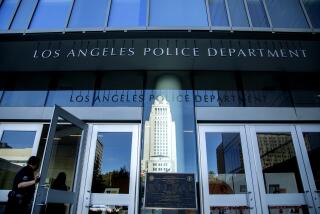Rethinking the Economy’s Link to Lawbreaking
- Share via
BRIDGEPORT, Conn. — When Connecticut’s largest city was mired in the economic slump of the early 1990s, the homicide toll climbed to record levels and drug dealers and gang leaders ruled, even charging tolls to cross their turf.
When economic relief came to Bridgeport in the late 1990s, violent crime fell, as it did in other big cities throughout the country.
It seemed obvious: Lead the state in unemployment; lead the state in homicides. Stop the recession; stop the violence. Crime and the economy move in opposite directions.
But recent years have turned that thinking on its head.
The drop-off in the stock market in 2000 brought tough economic times to Bridgeport. Since then, the region has lost more than 8,000 manufacturing jobs and city unemployment has more than doubled. Violent crime, meanwhile, has fallen 32%.
It wasn’t an aberration. From San Jose, Calif., to Chattanooga, Tenn., cities nationwide saw a dramatic drop in violent crime despite a downturn in the economy, spikes in unemployment and dips in the stock market.
It is a trend that is forcing police and criminologists to question the premise that crime is a product of the economy and only so much can be done to prevent it.
“They’re absolutely wrong,” Bridgeport Police Chief Wilbur L. Chapman said. “I couldn’t be more diametrically opposed to the idea that the economy drives crime.”
Bridgeport, population 140,000, saw 15 homicides last year, down from 60 a decade ago and 32 during the height of the late 1990s economic boom. Chapman, a product of the New York Police Department, attributes the decline not to an increase in officers -- he is down 57 -- but to the statistics-driven policing approach credited with polishing the Big Apple.
“The results have been nothing short of phenomenal,” Mayor John Fabrizi said.
New York called its program Compstat: Map every crime and put cops on the dots. Address quality-of-life issues. Clean the streets. Watch crime fall.
“It’s not rocket science. It’s breaking down various police units and holding them accountable for what’s going on,” said Steve Parks, police chief in Chattanooga, Tenn., where violent crime is down 32% since 2000. “We can’t control economic conditions, but there are some things law enforcement can do to control violent crime, even during a bad economy.”
Today, cities big and small are duplicating Compstat and changing the way experts think about crime.
“What we did over the past decade is realize that everything we thought about crime is wrong and we need to find out what does work,” said Gene Stephens, a former University of South Carolina criminal justice professor.
Stephens was one of many experts who, in the early 1990s, put much of the blame for rising crime rates on unemployment and poverty. Today, he is a consultant who teaches police officers that crime is not inevitable.
Police in successful cities say they do not let minor crimes go unnoticed and never let crime spikes become trends.
In Bridgeport, that meant some simple changes. The narcotics squad used to work weekday shifts. Chapman scheduled them overnight and on weekends. He put 20 officers inside housing projects to break the grip of the drug dealers. City Hall razed condemned buildings and cleaned up abandoned lots.
In San Jose, the heart of the Silicon Valley, the economy was never a problem. The nation’s 11th-largest city was home to some of the nation’s best-educated and best-paid workers. Then came the dot-com bust and police prepared for the worst.
But violent crime has fallen about 45% since 2000, even though unemployment hit 9.1% last year, nearly twice the national average.
Assistant Chief Dewey Hosmer said police made a priority of domestic violence calls, which tended to spike when people were out of work. Residents complained about speeding, so officers stepped up traffic enforcement. Traffic stops can lead to drug and gun arrests before anyone gets shot.
“You can’t say, ‘The economy’s going bad so crime is going to up, and there’s not much we can do,’ ” Hosmer said.
Everyone isn’t convinced that the economy-crime link is broken. Ohio State University economics professor Bruce A. Weinberg, for one, says he wants to see more data.
Even among the most successful cities, the data can be murky. Topeka, Kan., has cut violent crime nearly in half since 2000 but has struggled to control property crime.
But others believe the last decade has seen a remarkable change in crime control.
“A lot of people were fatalistic about crime, and we’ve proven you don’t have to be fatalistic about it,” Stephens said.
More to Read
Sign up for Essential California
The most important California stories and recommendations in your inbox every morning.
You may occasionally receive promotional content from the Los Angeles Times.










